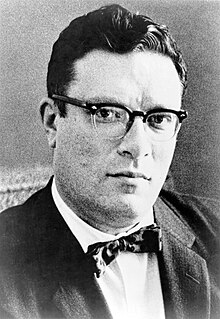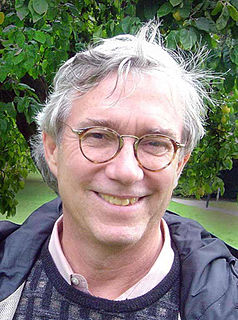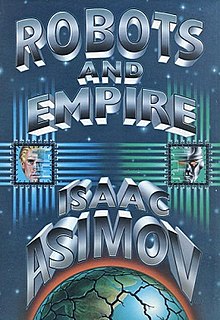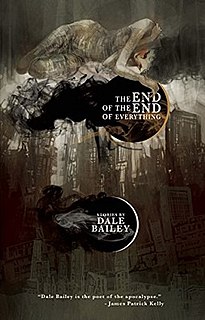
Isaac Asimov was an American writer and professor of biochemistry at Boston University. During his lifetime, Asimov was considered one of the "Big Three" science fiction writers, along with Robert A. Heinlein and Arthur C. Clarke. A prolific writer, he wrote or edited more than 500 books. He also wrote an estimated 90,000 letters and postcards. Best known for his hard science fiction, Asimov also wrote mysteries and fantasy, as well as much nonfiction.

Rudolf von Bitter Rucker is an American mathematician, computer scientist, science fiction author, and one of the founders of the cyberpunk literary movement. The author of both fiction and non-fiction, he is best known for the novels in the Ware Tetralogy, the first two of which both won Philip K. Dick Awards. Until its closure in 2014 he edited the science fiction webzine Flurb.

Robots and Empire is a science fiction novel by the American author Isaac Asimov, published by Doubleday Books in 1985. It is part of Asimov's Robot series, which consists of many short stories and five novels.

Damien Francis Broderick is an Australian science fiction and popular science writer and editor of some 74 books. His science fiction novel The Dreaming Dragons (1980) introduced the trope of the generation time machine, his The Judas Mandala (1982) contains the first appearance of the term "virtual reality" in science fiction, and his 1997 popular science book The Spike was the first to investigate the technological singularity in detail.
This is a bibliography of the books written or edited by Isaac Asimov, arranged alphabetically. Asimov was a prolific author, and he engaged in many collaborations with other authors. This list may not yet be complete. The total number of books listed here is over 500. Asimov died in 1992 at age 72; a small number of his books were published posthumously.
Michael Lawson Bishop is an American writer. Over four decades and in more than thirty books, he has created what has been called a "body of work that stands among the most admired and influential in modern science fiction and fantasy literature."
Biopunk is a subgenre of science fiction that focuses on biotechnology. It is derived from cyberpunk, but focuses on the implications of biotechnology rather than mechanical cyberware and information technology. Biopunk is concerned with synthetic biology. It is derived of cyberpunk involving bio-hackers, biotech megacorporations, and oppressive government agencies that manipulate human DNA. Most often keeping with the dark atmosphere of cyberpunk, biopunk generally examines the dark side of genetic engineering and represents the low side of biotechnology.
The first Golden Age of Science Fiction, often recognized in the United States as the period from 1938 to 1946, was an era during which the science fiction genre gained wide public attention and many classic science fiction stories were published. In the history of science fiction, the Golden Age follows the "pulp era" of the 1920s and 1930s, and precedes New Wave science fiction of the 1960s and 1970s. The 1950s are a transitional period in this scheme; however, Robert Silverberg, who came of age in the 1950s, saw that decade as the true Golden Age.

Paul Di Filippo is an American science fiction writer. He is a regular reviewer for print magazines Asimov's Science Fiction, The Magazine of Fantasy and Science Fiction, Science Fiction Eye, The New York Review of Science Fiction, Interzone, and Nova Express, as well as online at Science Fiction Weekly. He is a member of the Turkey City Writer's Workshop. Along with Michael Bishop, Di Filippo has published a series of novels under the pseudonym Philip Lawson.

"A Martian Odyssey" is a science fiction short story by American writer Stanley G. Weinbaum originally published in the July 1934 issue of Wonder Stories. It was Weinbaum's second published story, and remains his best known. It was followed four months later by a sequel, "Valley of Dreams". These are the only stories by Weinbaum set on Mars.
Paul Cook is an American science fiction writer and classical music critic. He is a Principal Lecturer in the English Department at Arizona State University.
Chris Beckett is a British social worker, university lecturer, and science fiction author. He has written several textbooks, dozens of short stories, and six novels.

The Robert E. Howard Reader is a collection of essays on fantasy writer Robert E. Howard and his works, edited by Darrell Schweitzer. Originally scheduled for publication in 2007, it was ultimately published in September 2010 by Wildside Press.

The Sinners of Erspia is the fifteenth science fiction novel by Barrington J. Bayley. The main character is the interstellar courier Laedo, who is stranded on the bizarre artificial planetoid Erspia. The novel focuses on his attempts to gain an understanding of Erspia and Erspia's creator, the god-like Klystar. The novel was completed in 1997 and was first published as a print-on-demand book in 2002.

The Astounding, the Amazing, and the Unknown is an alternate historical adventure novel written by Paul Malmont, the sequel to The Chinatown Death Cloud Peril (2007). It features real-life pulp magazine authors of the past as the heroes of adventures reminiscent of their favored genres. The book was first published in hardcover by Simon & Schuster and audiobook by Brilliance Audio in July 2011. The title is drawn from those of the magazines, Astounding Science-Fiction, Amazing Stories, and Unknown, for which his main protagonists wrote.
"Danny Goes to Mars" is a science fiction short story by American writer Pamela Sargent. It was first published in Isaac Asimov's Science Fiction Magazine, in October 1992.
Child of the Light is a novel by Janet Berliner and George Guthridge published by White Wolf in 1991.
Humility Garden is a novel by Felicity Savage published by ROC in 1995.

The End of the End of Everything: Stories is a collection of horror and dark fantasy short stories by American writer Dale Bailey. It was first published by Arche Press in paperback and ebook in April 2015.
Suzanne Palmer is a writer of science fiction known for her novelette "The Secret Life of Bots" which won a Hugo Award in 2018. The story also won a Washington Science Fiction Association Small Press Award, and was a finalist for the Theodore A. Sturgeon Memorial Award.









